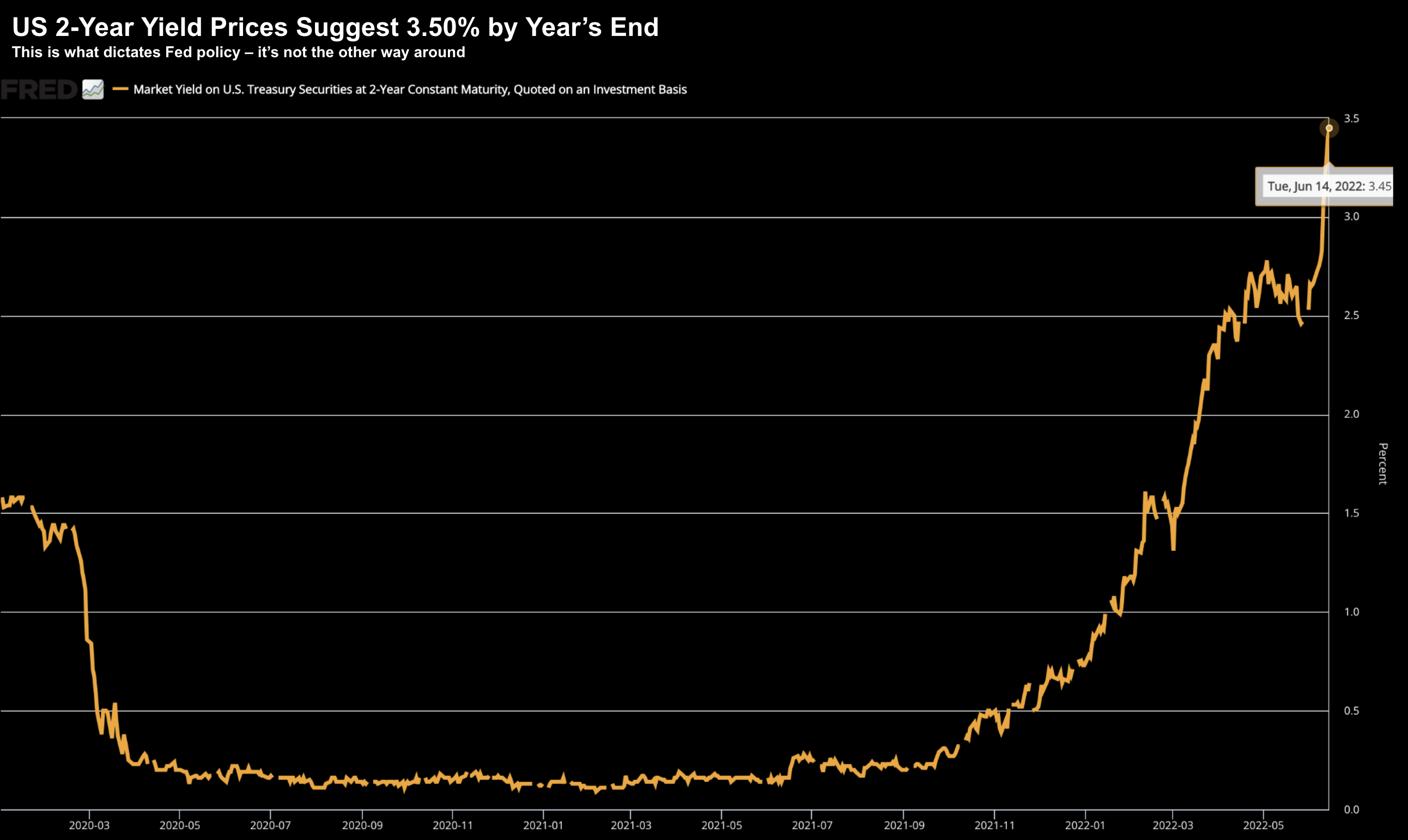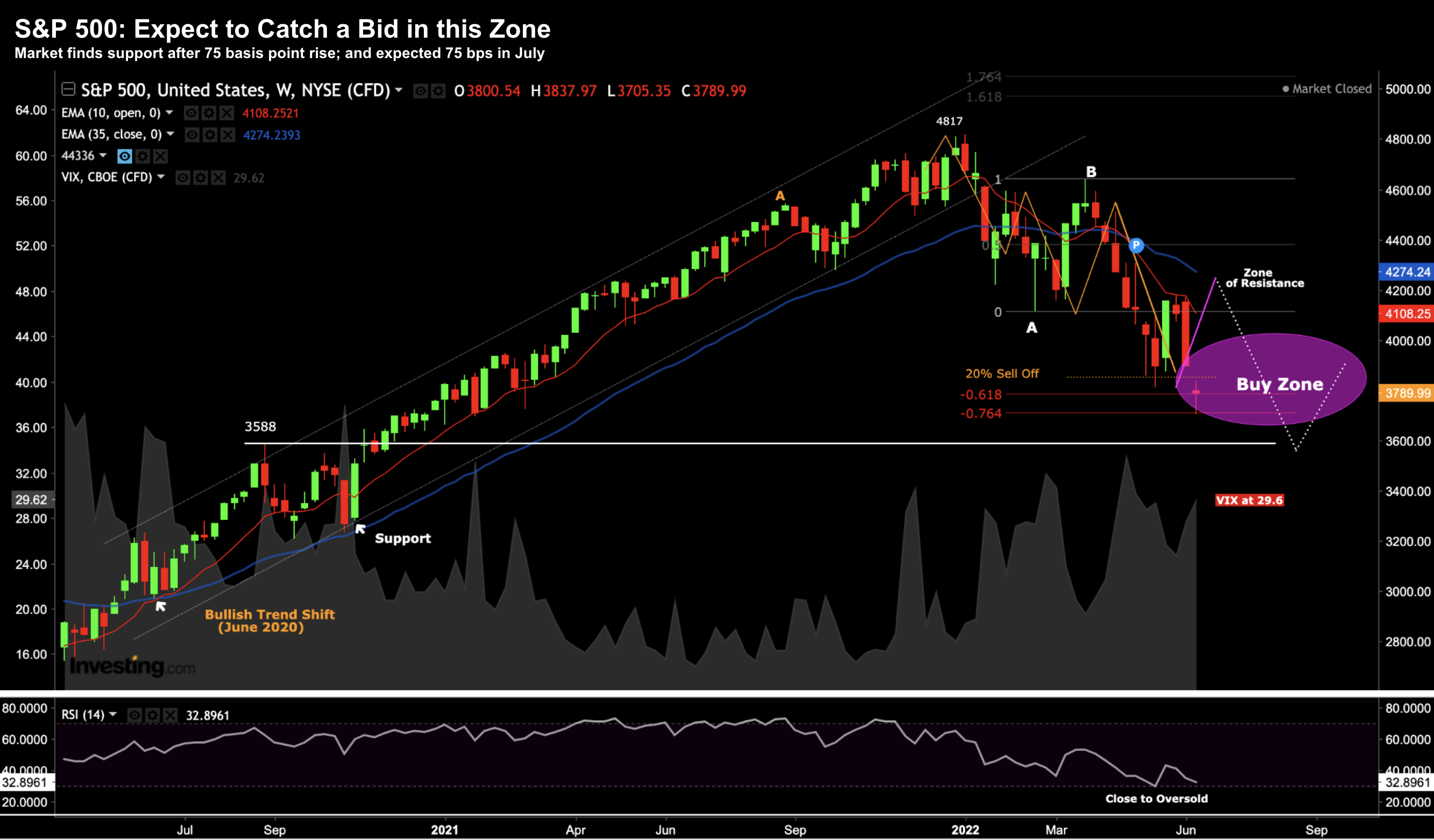- Bond market dictates what the Fed does
- Rates at 3.50% at year’s end – but will it be effective?
- What’s needed are positive real rates
Yesterday I said a 75 basis point (bps) rise was a lock.
What’s more – the market had fully priced it in – where I added:
“… on the basis we see 75 bps from the Fed tomorrow – I think the market behaves positively“
It did.
With respect to July – I would hazard a guess that 75 bps is now locked in (more on this in a moment).
Here’s CNBC on today’s news:
Ending weeks of speculation, the rate-setting FOMC took the level of its benchmark funds rate to a range of 1.5%-1.75%, the highest since just before the Covid pandemic began in March 2020
Powell Corrects his Language Mistake
Back in May – I said Jay Powell made a mistake (one he would regret).
He told the market the FOMC was not even considering a 75 bps hike in June.
Mmm…
Why take away optionality with CPI ripping above 8%?
Wrong move Jay.
Always leave your options open.
Today he ate humble pie with his language.
But it does make us question why would we give Powell any weight going forward?
Powell doesn’t know. The FOMC don’t know.
He and the Fed are completely data dependent.
What’s more, they are reactionary.
They are taking “post measures” to tackling inflation… not proactive measures.
What’s needed is the latter… a bit of gumption.
He needs to stare into the whites of inflation’s eyes and beat it into submission.
For example, why not lead with 100 bps in July?
I doubt we will see it – but with CPI at 8.6% – Powell needs inflation to be below the forecast neutral rate (whatever that is said to be)
That’s what’s needed.
And it’s what Volcker did in the early 1980s.
Now if you want to know what’s about to come out of Powell’s mouth – look no further than the 2-Year Treasury yield.
June 16 2022
For example, the 2-year is already telling me to expect 2x 75 bps plus 1x 50 bps this year.
Here’s my math:
1.50% + (2 x 0.75%) + (1 x 0.50%) = 3.50%
That’s why I think we will see Powell continue with 75 basis in July.
But this is the market is doing the Fed’s work.
Perhaps the small bit of good news today is at least the Fed’s so-called language is inching towards what the bond market is already saying.
Question I have is whether equity markets have priced in an effective rate of 3.50% at the end of 2022?
I don’t think so – not yet.
Is CPI Higher than 8.6%?
If you ask the average person if inflation is only 8.6% year on year – they will say “we wish”
Food, gas, rents are all up a lot more than 8%.
So what gives?
Now economist Larry Summers suggests it’s all in the way it’s measured… which can be misleading.
In this article – Summers said if we apply the same 1980’s methodology to measuring inflation today – it’s closer to 13% YoY.
And that’s probably a number which is closer to reality.
Here’s Fortune:
In a new paper published by the National Bureau of Economic Research, a nonprofit and nonpartisan economic research organization, Summers and his coauthors claim to have devised a new methodology to analyze inflation that they say is more accurate than the consumer price index (CPI), the most widely used yardstick. And what it finds is that taming today’s inflation might require a much more aggressive Federal Reserve.
“Using these series, we find that current inflation levels are much closer to past inflation peaks than the official series would suggest,” the authors wrote.
Summers and the paper’s coauthors, economists Judd Cramer and Marijn Bolhuis, write that the new metric better analyzes modern spending patterns than the CPI.
…
Summers and colleagues argue that this caused inflation measures before 1983 to look “artificially high at the beginning of the tightening cycle,” and to recede “artificially fast.
According to Summers’ methodology, today’s inflation rate is dangerously close to that of another period of economic distress in U.S. history: the early 1980s.
In 1980, the official inflation rate was 13.6%, although Summers’ index puts it at 9.1% when the alleged problem with housing spending is removed
If Summers is right, his index would have huge implications for how far the Federal Reserve may have to go to fix inflation. It could mean that the Fed would have to resort to the same extreme means employed by the central bank to tame inflation in the 1980s under former Chairman Paul Volcker
If we look at today’s CPI methodology – housing is said to constitute around one third of the measure.
However, the Fed (or Bureau of Stats) tells us that housing is only up 5.4% year on year?
Where?
Again, I cant tell you what’s in their sample data set is; or how they are doing their math – as housing is up a lot more than 5.4%
For example, single family homes are up something like 30% (pending which Index you choose). At their worst – they are up something like 20% year on year.
During the pandemic, low mortgage rates helped drive prices up even more sharply — between 30-40% in just the past two years depending on which price index you look at.
Meanwhile, both the pandemic and the war in Ukraine have shaken up supply chains. Costs for residential building materials are up 19% year-over-year, NAHB’s chief economist Robert Dietz said in a recent release
Note: Jay Powell has an important message for home buyers in my conclusion.
Now if we actually use home prices as a measure of inflation (and not some random construct like “owners equivalent rent”) – then you have an inflation rate which is much higher than “just 5%”.
As Summer’s put it – the inflation rate in 1980 would be revised from 13.5% to around 9% – if using today’s revised methodology.
And we all know what Paul Volcker had to do to squash the 1980-equivalent of today’s CPI “9%”
The required fix from central bankers hasn’t changed… they need to get real rates in positive territory.
And that’s not happening this year… maybe not even next.
Therefore expect CPI to continue to have a 6-handle throughout 2022… which will be painful for many low-to-middle income households.
Market Reactions
As I said yesterday – the equity market was likely to react positively to a rate hike of 75 basis points.
And right on cue – that’s what we saw.
The S&P 500 was up 1.46% and the Nasdaq rallied 2.50% (both well off session highs).
But again – I am not reading too much into this knee-jerk reaction.
All we saw today was the market got what they expected.
Nothing materially has changed from the script I have been sharing the past 6 months or so.
June 16 2022
It’s plausible the market catches a near-term bid here… however it’s far from out of the woods.
However, I maintain the lows for the S&P 500 in 2022 are not yet in.
Profit margins, earnings expectations and GDP growth will all continue to come down over the coming months.
A series of multiple 75 basis point rate rises does nothing to curb that from happening.
Rate rises will not change the supply / demand equation for energy, wages and rents in the near-term.
However, what it does is simply get the Fed closer to what the bond market already expects.
With respect to the 10-year treasury yields – they actually pulled back post Powell’s comments – trading down to 3.28% – after touching a new 11-year high yesterday.
Not surprisingly, the US dollar also pulled back from near-term overbought levels.
Putting it All Together…
Thinking more broadly – the Fed is now closer to the market.
Again, it’s the market which leads the Fed (not the other way around).
For example, you only need to see where the 2-year yield trades.
The Fed is now on a path towards an effective rate of 3.50% at the end of the year.
That said, they still need to pull the trigger.
75 basis points again in July (and September) is a step in the right direction… however a nominal rate of 3.50% is still far too low to have a material impact on inflation.
At best we might get to a 6-handle in December.
Yes it’s better than 8.6% today – but 6 is still unacceptably high.
Remember:
Real rates at negative ~7% today need to be positive to bring inflation back to 2-3%
That’s what Volcker did in the 1980s.
From an equity market perspective – we have priced in a portion of the downside risks.
But not all of it…
For example, we’re yet to fully factor in the earnings revisions which are coming down the pike. This is likely to see equities under pressure (especially at current multiples)
Don’t be surprised to see a near-term technical rally… but I am not reading too much into it.
Now before I close…
Powell offered a great bit of free advice for new (younger) home buyers.
He said (and I’m paraphrasing here):
- “… if you’re a young person looking to buy a home – you need to a bit of reset. We need to get back to where housing supply and demand are back together… where inflation is low again.. and mortgage rates are low again”
Now if that’s not Powell saying the Fed are intentionally trying to cool the housing market – I don’t know what is!


